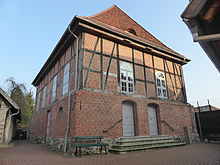Old Synagogue (Hagenow)
The old synagogue in Hagenow was the religious center of the local Jewish community. The ensemble of buildings consisting of a synagogue , a former parish and school building with a preserved mikveh and a car depot, which was renovated from 2004 onwards , is now a cultural center and part of the Hagenow local museum as the Hanna Opinion House . The current name is intended to recall the last Jewish child born in Hagenow, Hanna Opinions , who was murdered in Auschwitz in 1942 at the age of under two .
history
At the site of the synagogue there was already a prayer room in 1781, which had become too small due to the influx of other protective Jews and their families. In 1819 the growing Jewish community planned to build its own synagogue. In 1820, the mayor of the community, Hirsch Samuel opinions, bought a garden in Hagenstrasse as a building site for 100 Reichstaler, for which the building permit was granted in 1822. The building complex consisting of three half-timbered buildings was completed in 1828: a front building with a school, rooms for the community and a small apartment for the teacher, a coach house and the synagogue building in the back yard. The Hagenow Jewish Community, officially in existence since 1825 , inaugurated the synagogue on August 15, 1828.
As a result of the emigration of Jews to large cities and overseas from the middle of the 19th century, the community shrank so much that the last service was held in the synagogue in 1907.
After that, the synagogue was no longer used and was empty. Even so, the family of community leader Samuel Opinions continued to take care of the building. In order to be able to manage the maintenance of the synagogue financially, Samuel Ideen planned in 1932 to rent the synagogue house to the Catholic Church. The application to the Israelite High Council was rejected by the regional rabbi of Mecklenburg-Schwerin Siegfried Silberstein for religious reasons. Instead, he demanded the sale, but this did not take place until he died in 1937.
During the Reichspogromnacht the synagogue was desecrated and its interior devastated, but not set on fire like many other synagogues in the German Empire because of its proximity to other buildings . On June 22, 1942, the entire synagogue complex was forced to the foreman of the airfield sold Hagenow, later used among other things as production and storage hall, then left to rot. Three years after German reunification , the buildings were transferred to the Jewish Claims Conference . She sold this to the city of Hagenow in 2001.
present
Today the local and regional history of the Jewish citizens is presented in several rooms in the former school and community building. The groundwater-fed mikvah with a barrel made of oak boards sunk into the ground has been completely preserved.
Nowadays, cultural events take place in the actual synagogue. During the restoration of the building, old layers of paint were exposed on the front of the prayer room, from which the outline of the destroyed Toran niche can be recognized.
See also
Web links
Individual evidence
- ↑ a b The 'Old Synagogue Hagenow' cultural center and Hanna Opinion House. Brochure published by the city of Hagenow. June 2009. p. 7ff.
- ↑ Brief description of the building ensemble on the website of the city of Hagenow; accessed on February 23, 2015
- ↑ a b Historical details of the Hagenow synagogue ; Retrieved April 19, 2017
- ^ History of the Jews in Hagenow ; Retrieved April 19, 2017
- ↑ Land register extract Hagenow: p. 428; Transfer of land on July 6, 1942.
- ↑ The transfer back took place on November 8, 1993 (field number 86, Hagenstr. 48), one day before the 55th anniversary of the pogrom night of 1938.
- ^ Report on the Old Synagogue in the NDR , accessed on April 19, 2017
Coordinates: 53 ° 25 ′ 59.9 ″ N , 11 ° 11 ′ 12.2 ″ E

